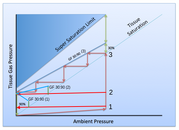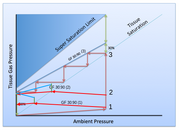By way of explanation, I've augmented a graphic I found at Simply Scuba:

Bombing down to, say, 100 ft, you stay for 1 minute, which takes you to Point 1 with regard to tissue loading. You then ascend (trajectory shown in red), until you reach the point where that tissue loading (having slightly increased during the ascent) reaches ambient pressure. That anchors the right endpoint of the GF(1) line (shown in blue here using GF 30/90). You continue ascent WITHOUT crossing the GF(1) line -- therefore no stops required -- arriving at the surface with a tissue loading around 40% (eyeballing based on the left endpoint of the GF line at 90%). This is a dive well within no-stop limits.
If you stay until Point 2, the direct ascent (red arrows) would fall just shy of the blue GF(2) line, and the point of closest approach is at surface pressure. This is a dive just shy of the no-stop limit.
If you stay until Point 3, ascending (moving left in the graphic, rust colored arrow) hits the blue GF(3) line, indicating a stop must be made. Tissue tension reduces while you wait (trajectory moves down in the graphic). Thus, this is a decompression dive.
Hopefully it's clear that it's impossible to cross any GF line unless tissue loading is higher than GFHigh (left endpoint of all of the GF lines). If your trajectory surfaces below GFHigh (as from Point 1), GFLow values from 1 to 100 cannot reposition the line so that it is crossed. That's why GFLow has no bearing on whether stops are required. It is only AFTER it's been established that the line is crossed somewhere -- i.e., tissue loading is sufficiently above GFHigh -- that you must look to GFLow to see exactly where.
(Of course, each tissue compartment is playing this game. If none cross, then no stops are made. Again, the NDL limit occurs when the worst-case or "controlling" compartment just clips the GF Line at surface pressure which is exactly GFHigh.)
Bombing down to, say, 100 ft, you stay for 1 minute, which takes you to Point 1 with regard to tissue loading. You then ascend (trajectory shown in red), until you reach the point where that tissue loading (having slightly increased during the ascent) reaches ambient pressure. That anchors the right endpoint of the GF(1) line (shown in blue here using GF 30/90). You continue ascent WITHOUT crossing the GF(1) line -- therefore no stops required -- arriving at the surface with a tissue loading around 40% (eyeballing based on the left endpoint of the GF line at 90%). This is a dive well within no-stop limits.
If you stay until Point 2, the direct ascent (red arrows) would fall just shy of the blue GF(2) line, and the point of closest approach is at surface pressure. This is a dive just shy of the no-stop limit.
If you stay until Point 3, ascending (moving left in the graphic, rust colored arrow) hits the blue GF(3) line, indicating a stop must be made. Tissue tension reduces while you wait (trajectory moves down in the graphic). Thus, this is a decompression dive.
Hopefully it's clear that it's impossible to cross any GF line unless tissue loading is higher than GFHigh (left endpoint of all of the GF lines). If your trajectory surfaces below GFHigh (as from Point 1), GFLow values from 1 to 100 cannot reposition the line so that it is crossed. That's why GFLow has no bearing on whether stops are required. It is only AFTER it's been established that the line is crossed somewhere -- i.e., tissue loading is sufficiently above GFHigh -- that you must look to GFLow to see exactly where.
(Of course, each tissue compartment is playing this game. If none cross, then no stops are made. Again, the NDL limit occurs when the worst-case or "controlling" compartment just clips the GF Line at surface pressure which is exactly GFHigh.)





